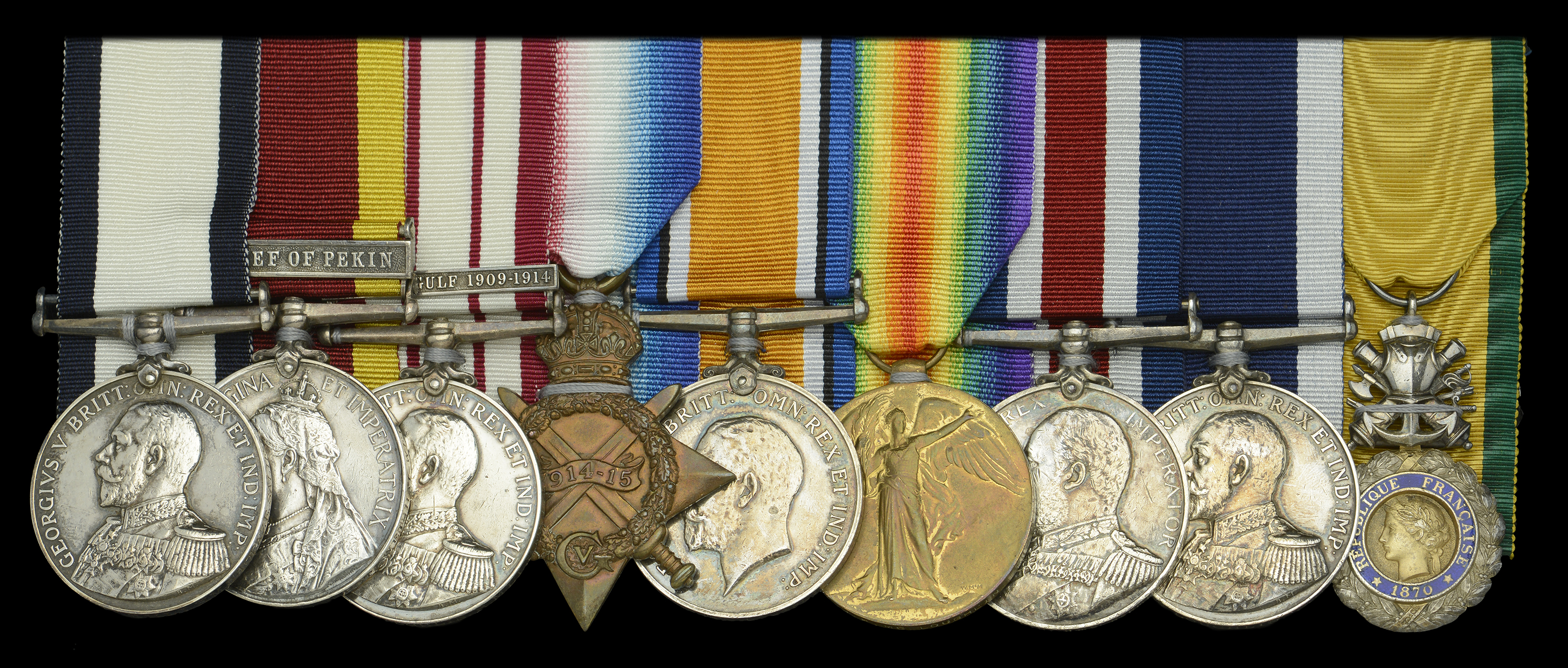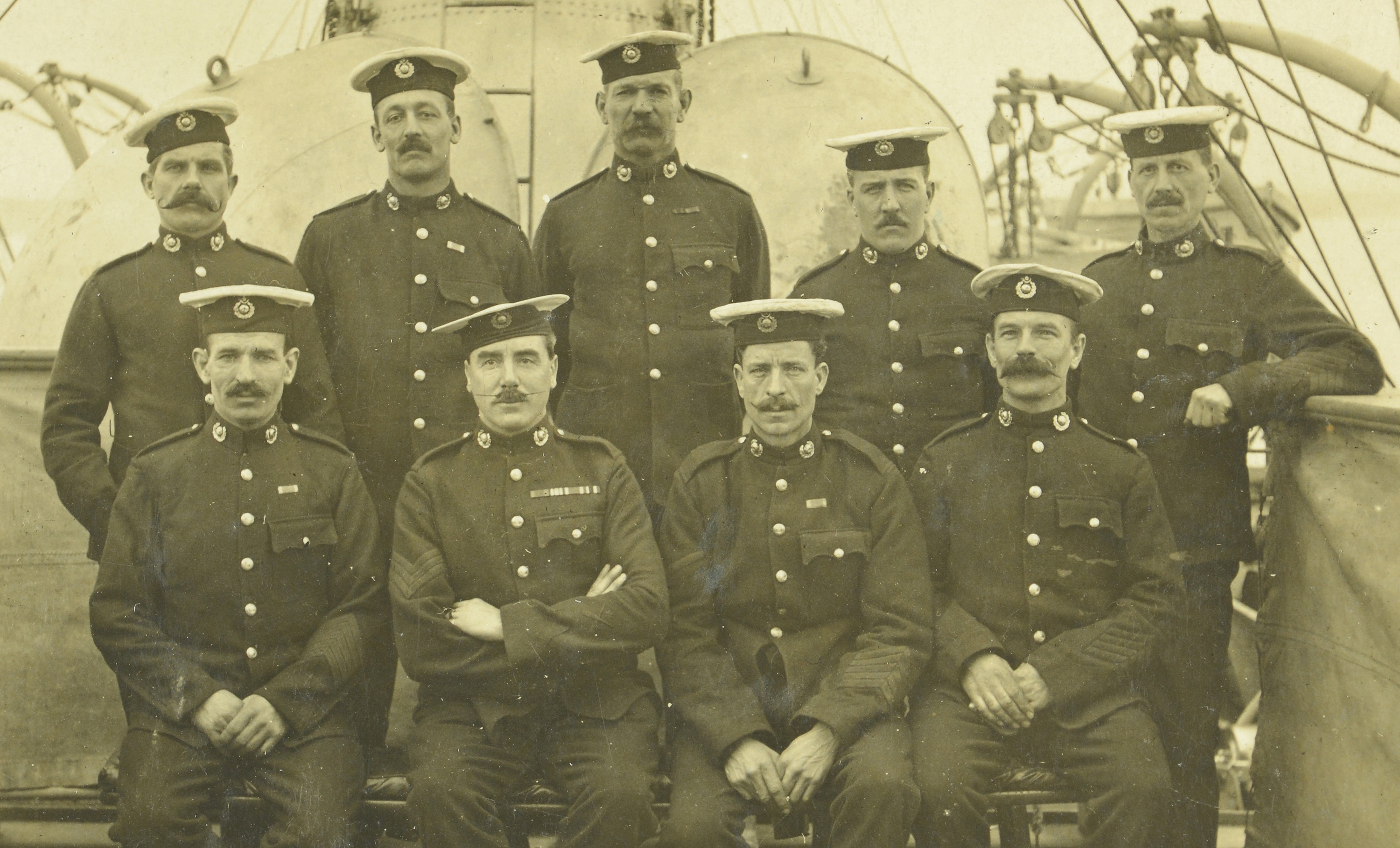The unique Great War Red Sea operations C.G.M. group of nine awarded to Sergeant J. F. McLaughlin, Royal Marine Light Infantry, who was decorated for his gallant deeds at the capture of Salif in June 1917 Conspicuous Gallantry Medal, G.V.R. (P.O. 8873. Sergt. J. F. McLaughlin, R.M.L.I. H.M.S. Topaze. Salif. 12. June 1917); China 1900, 1 clasp, Relief of Pekin (P.O. 8873. J. F. McLaughlin, Pte., R.M., Nav. Depot. Wei-Hai-Wei.); Naval General Service 1915-62, 1 clasp, Persian Gulf 1909-1914 (P.O. 8873. Corpl. J. F. McLaughlin. R.M.L.I. H.M.S. Proserpine); 1914-15 Star (P.O. 8873. Sgt. J. F. McLaughlin. R.M.L.I.); British War and Victory Medals (P.O. 8873 Sgt. J. F. McLaughlin. R.M.L.I.); Naval Good Shooting Medal, E.VII.R. (P.O. 8873. Cpl. J. F. McLaughlin, H.M.S. Hermione. 1910. 6 In. Q.F.); Royal Navy L.S. & G.C., G.V.R., 1st issue (P.O. 8873 J. F. McLaughlin, Corporal R.M.L.I.); France, 3rd Republic, Medaille Militaire, silver, silver-gilt and enamel, contact marks, otherwise very fine or better (9) £12,000-£16,000 --- Importation Duty This lot is subject to importation duty of 5% on the hammer price unless exported outside the UK --- --- Provenance: Dix Noonan Webb, June 1999. A unique combination of awards to the Royal Marines. C.G.M. London Gazette 11 August 1917: ‘For conspicuous gallantry at the capture of Salif on the 12 June 1917. Just before the surrender he came across 11 unwounded and 1 wounded Turkish soldiers. Followed by one Petty Officer, Sergeant McLaughlin jumped among them, shot one, and made seven surrender.’ James Francis McLaughlin was born in Gibraltar on 6 January 1878, and joined the Royal Marine Light Infantry at Eastney in January 1897. Among those landed with the North China Field Force in July 1900, he took part in the relief of Pekin operations in the following month, in addition to serving at the R.M. depot at Wei-Hei-Wei. Advanced to Corporal in February 1902, he subsequently qualified as a gun layer and 2nd captain of gun and, whilst serving in H.M.S. Hermione in 1910, he was awarded the Naval Good Shooting Medal for his skills on her 6-inch Quick Firing gun. Having then witnessed active service in the Persian Gulf aboard the Proserpine, he added the L.S. & G.C. Medal to his accolades in August 1912. Advanced to Sergeant in June 1913, McLaughlin was serving in the battleship Queen on the outbreak of hostilities, and he quickly saw action off Gallipoli during the landings in April 1915. Transferring to the Topaze in the Adriatic in February 1916, he participated in operations in support of the Regia Marina, prior to her transfer to the East Indies station in March 1917. Red Sea C.G.M. Operating out of Aden, Topaze saw action against the Turks in support of the South Arabian campaign, her guns contributing to the bombardment of enemy positions on the island of Kamaran on 10 June 1917. But it was for his deeds in a related action at Salif two days later that McLaughlin was awarded his C.G.M., when Topaze and her consorts closed the enemy batteries and landed parties of Marines and bluejackets to capture the position. Salif lies on a peninsula, the north end of which is a mud flat covered at high tide by the sea. On the east side of the village is a hill with a hollow depression in its face, in which the enemy garrison took up their position, when the ships approached at dawn on the 12th; here they were well screened from the fire of the ships. The Espiegle entered the inlet between the peninsula and the mainland, so as to bring a cross fire on the place. The Northbrook went close inshore at the south end of the peninsula; Minto, Topaze and Odin made a line to the north of her, as near the shore as possible. The Topaze and Odin ran in so close that the enemy could not depress their guns sufficiently to reach them. The Turks had two Krupp mountain guns and three one-inch Nordenfeldts; their shells did no harm as they had to be laid so that their line of fire would clear the crater. The Northbrook’s men landed at the south end of the peninsula and took up a position on the right of the town, the others all landed at the pier and extended behind a ridge, which was flanked by a salt mine on the south, and by houses on the north. The Royal Marines were in the centre of the line. The Odin’s seamen entered the village and took possession of the condensing plant and the telegraph office. Commander A. R. Woods, D.S.O., R.N., of the Topaze, was in command, with Commander Salmond second-in-command; there was no Royal Marine officer present. The ships’ guns fired a barrage on the hill, and under cover of this the parties advanced and gained the foot of the hill. The attack was directed against three sides, the fourth being closed by the Espiegle. At a given signal, the hill was rushed and they completely surrounded the Turks, who made a good fight, the engagement lasting for over three hours. In the course of the fighting, McLaughlin encountered 12 Turkish soldiers and went for them single handed, followed by one Petty Officer, and between them they shot one, took seven prisoner and the rest bolted. He and two Naval ratings were subsequently awarded the C.G.M., whilst Commander Woods was awarded a Bar to his D.S.O. McLaughlin remained employed in the Topaze until the summer of 1918, when he returned home to an appointment in the Portsmouth Division. He was demobilised and pensioned ashore in October 1919. Sold with his original parchment Certificates of Service (2), and another on paper; Certificate of Discharge and Character Certificate on Demobilisation; Pension Certificate for Conspicuous Gallantry, and a postcard photograph of McLaughlin and other Royal Marines aboard H.M.S. Topaze in 1917.









